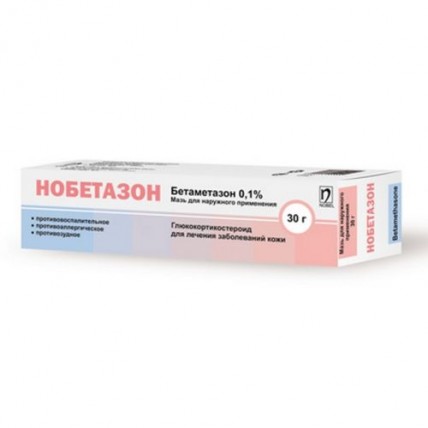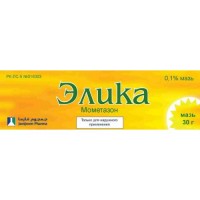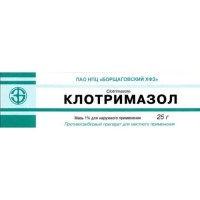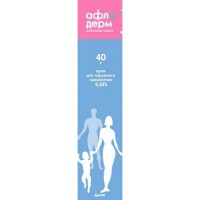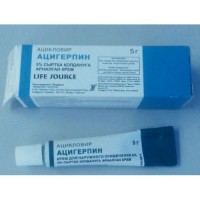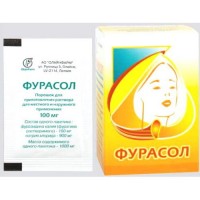Nobetazon 0.1% 30g ointment tube for external use
- $14.00
Compound
1 g of ointment contains
Data on the pharmacokinetics of the drug Nobetasone are not available.
Nobetasone has anti-inflammatory, antipruritic and vasoconstrictive effects. Betamethasone inhibits the release of cytokines and inflammatory mediators, reduces the metabolism of arachidonic acid, initiates the formation of lipocortins with anti-edematous activity, and reduces vascular permeability.
- inflammatory manifestations in dermatoses sensitive to corticosteroid therapy
- eczema (atopic, childhood, nummular)
- contact dermatitis
- seborrheic dermatitis
- neurodermatitis
- solar dermatitis
- exfoliative dermatitis
- stasis dermatitis
- radiation dermatitis
- intertriginous dermatitis
- psoriasis
- anogenital and senile itching
Nobetasone is applied in a thin layer to the affected areas of the skin 1-3 times a day, depending on the severity of the condition. In most cases, to achieve the effect, it is enough to apply 1-2 times a day. The frequency of application of the drug is determined according to the degree of damage. With a mild degree of damage, the drug can be applied once a day, in case of more severe lesions, the frequency of application of the drug must be increased.
The duration of the course of treatment is determined by the doctor depending on the severity and course of the disease.
The method of application in children is the same as in adults (see sections "Contraindications" and "Special Instructions").
- burning sensation
-skin irritation
- itching
-dry skin
- folliculitis
- hypertrichosis
- acne breakouts
-hypopigmentation
- perioral dermatitis
- allergic contact dermatitis
- skin maceration
- secondary infection
- skin atrophy
- stretch marks
- myalgia
Side effects in children
- inhibition of the function of the hypothalamic-pituitary-adrenal system
- Cushing's syndrome
- growth retardation
- lag in weight gain
- increased intracranial pressure.
- hypersensitivity to any component of the drug
- children's age up to 6 months
- pregnancy (use of high doses, long-term treatment) and lactation
Co-administration of drugs that can inhibit CYP3A4 (eg, ritonavir, itraconazole) generally inhibits the metabolism of corticosteroids and results in increased systemic exposure. The extent to which this interaction is clinically significant depends on the dose and routes of administration of corticosteroids, as well as the potential inhibitor of CYP3A4.
The drug is not intended for use in ophthalmology. When using the drug in the eyelids, make sure that the drug does not get into the eyes, as cataracts and glaucoma may develop as a result of repeated exposure.
If irritation or hypersensitivity is noted during the use of the drug, treatment should be discontinued and another therapy should be selected for the patient.
In the presence of an infection, antifungal or antibacterial agents should be prescribed, respectively. If at the same time the desired effect does not occur quickly, the use of corticosteroids should be stopped until the signs of infection have disappeared.
Any side effects that occur with systemic use of glucocorticoids, including suppression of the adrenal cortex, can also occur with their topical use, especially in infants and children.
Systemic absorption of topical corticosteroids may be increased when they are used for a long time, when treating a large body surface, or when using occlusive dressings.
Application in pediatrics
Children may be more susceptible to the action of local glucocorticosteroids, which cause depression of the hypothalamic-pituitary-adrenal system, than older patients. This is due to the higher absorption of the drug in children due to the greater ratio of surface area to body weight.
In infants and children, systemic absorption of topical glucocorticosteroids may be increased with prolonged use, treatment of large areas of the body, or use of dressings.
Features of the effect of the drug on the ability to drive a vehicle or potentially dangerous mechanisms.
The drug does not affect the ability to drive vehicles or complex technical devices.;
Symptoms. Excessive or prolonged use of topical glucocorticosteroids can cause depression of the pituitary-adrenal function, which can lead to the development of secondary adrenal insufficiency and the appearance of symptoms of hypercorticism, including Cushing's syndrome.
Treatment: Symptomatic treatment. If necessary, correction of electrolyte imbalance is indicated. In the case of chronic toxic effects, a gradual withdrawal of glucocorticosteroids is recommended.
Store at a temperature not exceeding 25°C, in a dry, dark place.
Keep out of the reach of children!
Shelf life - 2 years
Do not use the drug after the expiration date.
1 g of ointment contains
- active substance - betamethasone valerate 1.22 mg (equivalent to betamethasone 1 mg)
- excipients : liquid paraffin, white vaseline
Pharmacological properties
Pharmacokinetics
Data on the pharmacokinetics of the drug Nobetasone are not available.
Pharmacodynamics
Nobetasone has anti-inflammatory, antipruritic and vasoconstrictive effects. Betamethasone inhibits the release of cytokines and inflammatory mediators, reduces the metabolism of arachidonic acid, initiates the formation of lipocortins with anti-edematous activity, and reduces vascular permeability.
Indications for use
- inflammatory manifestations in dermatoses sensitive to corticosteroid therapy
- eczema (atopic, childhood, nummular)
- contact dermatitis
- seborrheic dermatitis
- neurodermatitis
- solar dermatitis
- exfoliative dermatitis
- stasis dermatitis
- radiation dermatitis
- intertriginous dermatitis
- psoriasis
- anogenital and senile itching
Dosage and administration
Nobetasone is applied in a thin layer to the affected areas of the skin 1-3 times a day, depending on the severity of the condition. In most cases, to achieve the effect, it is enough to apply 1-2 times a day. The frequency of application of the drug is determined according to the degree of damage. With a mild degree of damage, the drug can be applied once a day, in case of more severe lesions, the frequency of application of the drug must be increased.
The duration of the course of treatment is determined by the doctor depending on the severity and course of the disease.
The method of application in children is the same as in adults (see sections "Contraindications" and "Special Instructions").
Side effects
- burning sensation
-skin irritation
- itching
-dry skin
- folliculitis
- hypertrichosis
- acne breakouts
-hypopigmentation
- perioral dermatitis
- allergic contact dermatitis
- skin maceration
- secondary infection
- skin atrophy
- stretch marks
- myalgia
Side effects in children
- inhibition of the function of the hypothalamic-pituitary-adrenal system
- Cushing's syndrome
- growth retardation
- lag in weight gain
- increased intracranial pressure.
Contraindications
- hypersensitivity to any component of the drug
- children's age up to 6 months
- pregnancy (use of high doses, long-term treatment) and lactation
Drug Interactions
Co-administration of drugs that can inhibit CYP3A4 (eg, ritonavir, itraconazole) generally inhibits the metabolism of corticosteroids and results in increased systemic exposure. The extent to which this interaction is clinically significant depends on the dose and routes of administration of corticosteroids, as well as the potential inhibitor of CYP3A4.
Special instructions
The drug is not intended for use in ophthalmology. When using the drug in the eyelids, make sure that the drug does not get into the eyes, as cataracts and glaucoma may develop as a result of repeated exposure.
If irritation or hypersensitivity is noted during the use of the drug, treatment should be discontinued and another therapy should be selected for the patient.
In the presence of an infection, antifungal or antibacterial agents should be prescribed, respectively. If at the same time the desired effect does not occur quickly, the use of corticosteroids should be stopped until the signs of infection have disappeared.
Any side effects that occur with systemic use of glucocorticoids, including suppression of the adrenal cortex, can also occur with their topical use, especially in infants and children.
Systemic absorption of topical corticosteroids may be increased when they are used for a long time, when treating a large body surface, or when using occlusive dressings.
Application in pediatrics
Children may be more susceptible to the action of local glucocorticosteroids, which cause depression of the hypothalamic-pituitary-adrenal system, than older patients. This is due to the higher absorption of the drug in children due to the greater ratio of surface area to body weight.
In infants and children, systemic absorption of topical glucocorticosteroids may be increased with prolonged use, treatment of large areas of the body, or use of dressings.
Features of the effect of the drug on the ability to drive a vehicle or potentially dangerous mechanisms.
The drug does not affect the ability to drive vehicles or complex technical devices.;
Overdose
Symptoms. Excessive or prolonged use of topical glucocorticosteroids can cause depression of the pituitary-adrenal function, which can lead to the development of secondary adrenal insufficiency and the appearance of symptoms of hypercorticism, including Cushing's syndrome.
Treatment: Symptomatic treatment. If necessary, correction of electrolyte imbalance is indicated. In the case of chronic toxic effects, a gradual withdrawal of glucocorticosteroids is recommended.
Storage conditions
Store at a temperature not exceeding 25°C, in a dry, dark place.
Keep out of the reach of children!
Shelf life - 2 years
Do not use the drug after the expiration date.
